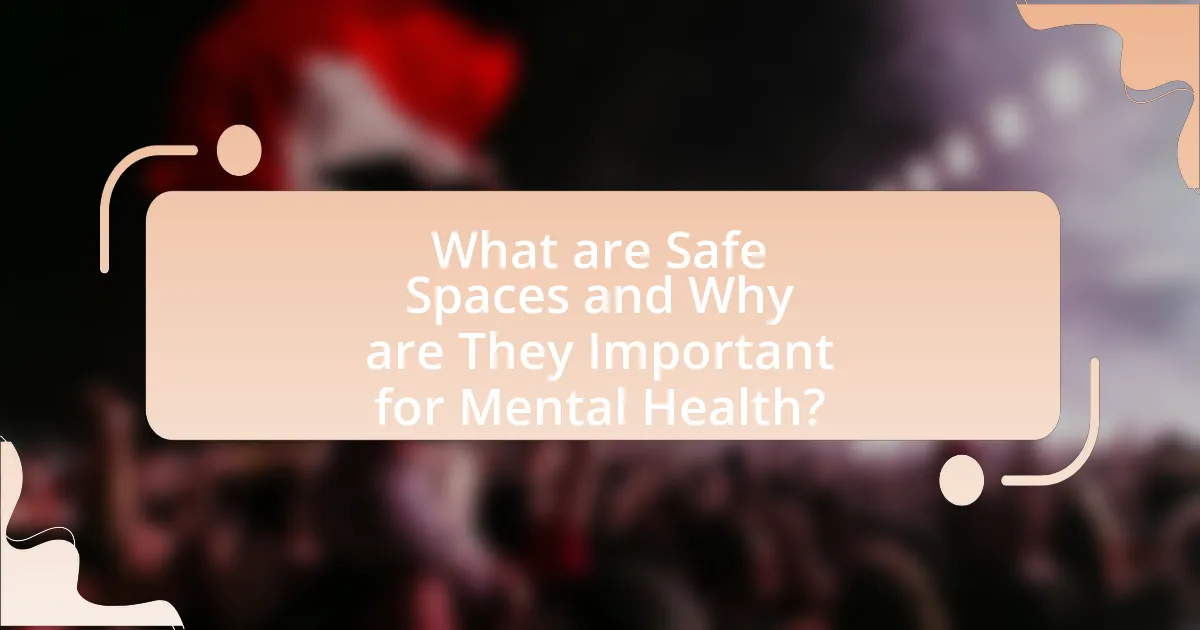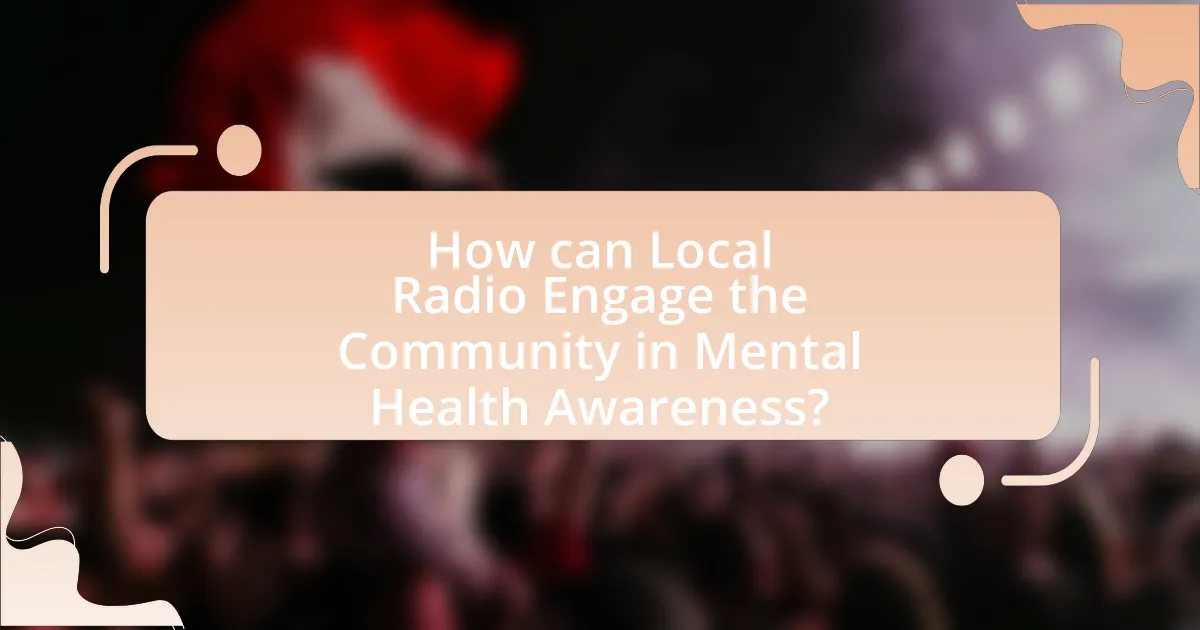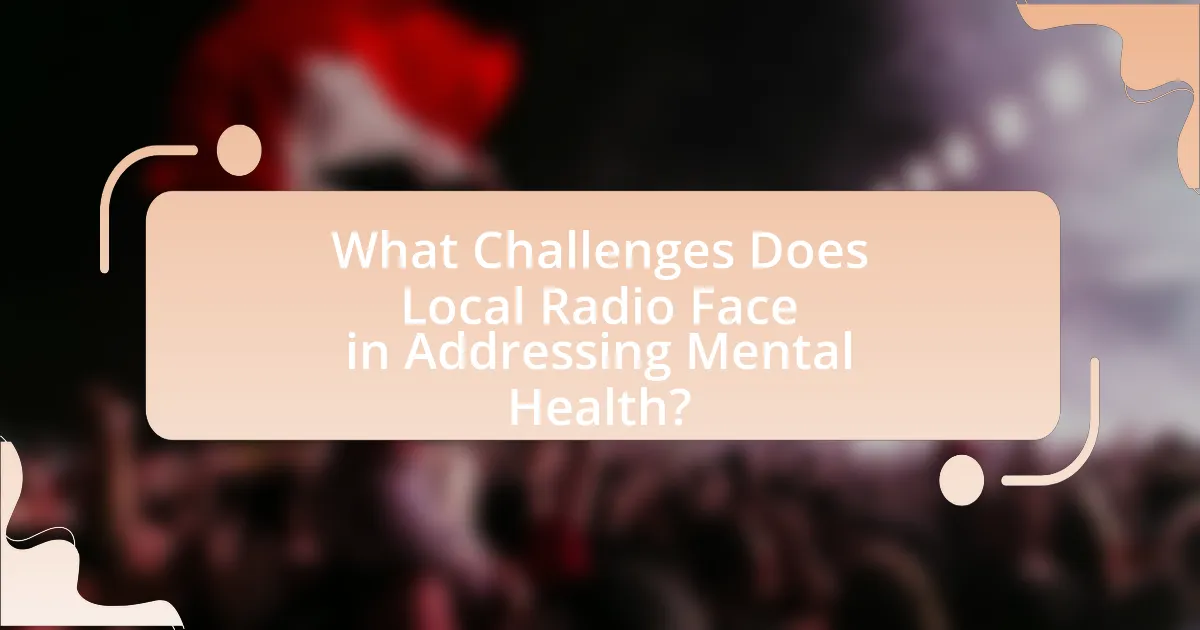The article focuses on the concept of safe spaces and their significance for mental health, particularly through the medium of local radio. It outlines how local radio can create supportive environments for mental health discussions by fostering open dialogue, reducing stigma, and enhancing community connections. Key strategies include engaging listeners through interactive programming, collaborating with mental health organizations, and sharing personal stories and expert insights. The article also addresses challenges faced by local radio in discussing mental health topics and emphasizes the importance of measuring the impact of mental health initiatives to ensure effective outreach and support within the community.

What are Safe Spaces and Why are They Important for Mental Health?
Safe spaces are environments where individuals can feel secure, accepted, and free from judgment, allowing them to express their thoughts and emotions openly. These spaces are crucial for mental health as they promote emotional well-being, reduce anxiety, and foster a sense of belonging. Research indicates that safe spaces can lead to improved mental health outcomes by providing support networks and encouraging open dialogue about mental health issues, which is essential for community healing and resilience.
How can local radio create safe spaces for mental health discussions?
Local radio can create safe spaces for mental health discussions by fostering open dialogue and providing a platform for community voices. By featuring mental health professionals and individuals sharing their experiences, local radio can normalize conversations around mental health, reducing stigma. Research indicates that community-based media can significantly impact public perceptions of mental health, as seen in studies by the World Health Organization, which highlight the role of local media in promoting mental well-being. Additionally, local radio can host call-in segments, allowing listeners to engage directly, thus creating an interactive environment that encourages participation and support.
What role does local radio play in fostering community connections?
Local radio plays a crucial role in fostering community connections by providing a platform for local voices, news, and events that resonate with residents. This medium facilitates engagement through discussions on community issues, promotes local events, and supports local businesses, thereby strengthening social ties. For instance, studies have shown that local radio stations often serve as a vital source of information during emergencies, enhancing community resilience and cohesion. Additionally, local radio can create a sense of belonging by featuring stories and experiences that reflect the community’s diversity, which is essential for mental health and well-being.
How can local radio address stigma surrounding mental health?
Local radio can address stigma surrounding mental health by providing a platform for open discussions, sharing personal stories, and featuring expert interviews. By broadcasting programs that normalize conversations about mental health, local radio can educate listeners about mental health issues, dispel myths, and promote understanding. Research indicates that media representation significantly influences public perceptions; for instance, a study published in the Journal of Health Communication found that positive portrayals of mental health can reduce stigma and encourage individuals to seek help. Therefore, local radio’s role in fostering dialogue and awareness is crucial in combating mental health stigma in the community.
What are the key elements of effective mental health programming on local radio?
Effective mental health programming on local radio includes accessibility, community engagement, expert involvement, and stigma reduction. Accessibility ensures that content is available to diverse audiences, including those with disabilities or language barriers. Community engagement involves incorporating local voices and stories, fostering a sense of belonging and relatability. Expert involvement, such as mental health professionals, provides credibility and accurate information, which is crucial for listener trust. Stigma reduction is achieved through open discussions and normalizing mental health topics, which can lead to increased awareness and support. Research indicates that community-based media can significantly impact public perceptions of mental health, making these elements essential for effective programming.
How can local radio hosts be trained to discuss mental health topics sensitively?
Local radio hosts can be trained to discuss mental health topics sensitively through structured training programs that focus on empathy, active listening, and informed communication. These programs should include workshops led by mental health professionals, which provide hosts with knowledge about mental health issues, stigma reduction, and appropriate language to use when discussing sensitive topics. Research indicates that training in these areas can significantly improve the quality of discussions around mental health, fostering a supportive environment for listeners. For example, a study published in the Journal of Mental Health found that media training for broadcasters led to a 40% increase in the use of non-stigmatizing language when discussing mental health.
What types of mental health content resonate most with listeners?
Mental health content that resonates most with listeners includes personal stories, expert interviews, and practical coping strategies. Personal stories create relatability and foster connection, as they allow listeners to see their own experiences reflected in others. Expert interviews provide credible information and insights, helping listeners understand mental health issues more deeply. Practical coping strategies offer actionable advice, empowering listeners to manage their mental health effectively. Research indicates that content featuring personal narratives and expert guidance significantly enhances listener engagement and retention, making it a vital component of mental health programming.

How can Local Radio Engage the Community in Mental Health Awareness?
Local radio can engage the community in mental health awareness by broadcasting informative programs that discuss mental health topics, share personal stories, and provide resources for support. These programs can feature interviews with mental health professionals, local advocates, and individuals who have experienced mental health challenges, creating a platform for open dialogue. Research indicates that community-based media can significantly influence public perceptions and behaviors regarding mental health, as seen in studies like the one published in the Journal of Community Health, which highlights the effectiveness of local media in disseminating health information and fostering community engagement. By actively involving listeners through call-ins, social media interactions, and community events, local radio can create a supportive environment that encourages individuals to seek help and reduces stigma surrounding mental health issues.
What strategies can local radio use to involve listeners in mental health initiatives?
Local radio can involve listeners in mental health initiatives by hosting interactive programs that encourage audience participation, such as call-in segments, live discussions, and social media engagement. These strategies foster a sense of community and provide a platform for sharing personal experiences and expert advice. For instance, a study by the National Alliance on Mental Illness indicates that community engagement in mental health discussions can reduce stigma and promote awareness, demonstrating the effectiveness of local radio in facilitating these conversations. Additionally, local radio can collaborate with mental health organizations to provide resources and information, further enhancing listener involvement and support.
How can listener feedback shape mental health programming?
Listener feedback can significantly shape mental health programming by providing insights into community needs and preferences. This feedback allows mental health programs to be tailored to address specific issues faced by listeners, ensuring that the content is relevant and effective. For instance, a study by the National Institute of Mental Health found that community-driven programming leads to higher engagement and better mental health outcomes, as it reflects the actual concerns and experiences of the audience. By actively incorporating listener suggestions and concerns, mental health programming can evolve to be more inclusive and supportive, ultimately fostering a stronger connection between the radio station and its community.
What partnerships can local radio form to enhance mental health outreach?
Local radio can enhance mental health outreach by forming partnerships with mental health organizations, schools, and community centers. Collaborating with mental health organizations allows local radio to provide expert insights, resources, and support for listeners, which can be evidenced by initiatives like the National Alliance on Mental Illness (NAMI) partnering with media outlets to raise awareness. Partnering with schools enables radio stations to reach younger audiences, promoting mental health education and resources directly to students and parents. Additionally, collaboration with community centers can facilitate local events and workshops, creating safe spaces for discussions about mental health, as demonstrated by community radio stations that have successfully hosted mental health fairs in collaboration with local health services.
How can local radio promote mental health resources effectively?
Local radio can effectively promote mental health resources by providing consistent, relatable programming that addresses mental health topics and shares available resources. By featuring expert interviews, personal stories, and community events, local radio can create a platform that normalizes discussions around mental health, thereby reducing stigma. Research indicates that community-based media can significantly influence public perceptions and behaviors regarding health issues, including mental health (McCombs & Shaw, 1972). Additionally, local radio can collaborate with mental health organizations to disseminate information about services, hotlines, and support groups, ensuring that listeners are aware of the resources available to them.
What are the best practices for sharing mental health resources on air?
The best practices for sharing mental health resources on air include providing accurate information, ensuring accessibility, and fostering a supportive environment. Accurate information involves citing reputable sources such as mental health organizations and professionals, which enhances credibility and trust. Accessibility can be achieved by using clear language and avoiding jargon, making the content understandable for a diverse audience. Fostering a supportive environment means encouraging open discussions about mental health, normalizing conversations, and providing listeners with actionable resources, such as hotlines or local support groups. These practices are essential for effectively addressing mental health issues within the community and promoting awareness.
How can local radio utilize social media to amplify mental health messages?
Local radio can utilize social media to amplify mental health messages by creating engaging content that encourages community interaction and sharing. By leveraging platforms like Facebook, Twitter, and Instagram, local radio stations can post informative articles, host live Q&A sessions with mental health professionals, and share personal stories from community members, which fosters a sense of connection and support. Research indicates that social media can enhance the reach of mental health campaigns; for instance, a study published in the Journal of Medical Internet Research found that social media campaigns significantly increased awareness and engagement regarding mental health issues. This demonstrates that local radio’s strategic use of social media not only broadens the audience but also cultivates a supportive environment for discussing mental health topics.

What Challenges Does Local Radio Face in Addressing Mental Health?
Local radio faces several challenges in addressing mental health, primarily due to limited resources, stigma, and lack of trained personnel. Limited financial and staffing resources restrict the ability of local radio stations to produce comprehensive mental health programming. Stigma surrounding mental health issues can deter listeners from engaging with content or seeking help, thereby reducing the effectiveness of outreach efforts. Additionally, the absence of trained mental health professionals within local radio teams can lead to the dissemination of inaccurate information, which may further harm listeners. These challenges hinder local radio’s potential to create safe spaces for mental health discussions in the community.
What barriers exist for local radio in discussing mental health topics?
Local radio faces several barriers in discussing mental health topics, primarily including stigma, lack of resources, and insufficient training. Stigma surrounding mental health can deter both radio hosts and listeners from engaging in open discussions, as fear of judgment or misunderstanding persists in many communities. Additionally, local radio stations often operate with limited budgets, which restricts their ability to access expert guests or produce high-quality content on mental health issues. Furthermore, many radio personnel may lack the necessary training to handle sensitive topics appropriately, leading to potential misinformation or inadequate support for listeners seeking help. These barriers collectively hinder local radio’s capacity to effectively address mental health in their communities.
How can local radio overcome funding limitations for mental health programming?
Local radio can overcome funding limitations for mental health programming by establishing partnerships with local mental health organizations and seeking grants specifically aimed at mental health initiatives. Collaborating with organizations such as the National Alliance on Mental Illness (NAMI) can provide access to resources and funding opportunities, as these organizations often have grants available for community outreach programs. Additionally, local radio stations can engage in fundraising campaigns, leveraging community support to raise funds for specific mental health programming. According to a report by the Pew Research Center, community-driven initiatives can significantly enhance local engagement and funding, demonstrating that grassroots support is a viable strategy for sustaining mental health programming.
What are the challenges of reaching diverse audiences with mental health content?
Reaching diverse audiences with mental health content presents challenges such as cultural stigma, varying levels of mental health literacy, and language barriers. Cultural stigma can prevent individuals from engaging with mental health resources, as certain communities may view mental health issues as a sign of weakness. Additionally, varying levels of mental health literacy mean that some audiences may not fully understand mental health concepts or the importance of seeking help, which can hinder effective communication. Language barriers further complicate outreach efforts, as mental health content may not be accessible to non-native speakers or those who prefer information in their native language. These challenges necessitate tailored approaches to ensure that mental health content resonates with and is accessible to all segments of the community.
How can local radio measure the impact of its mental health initiatives?
Local radio can measure the impact of its mental health initiatives through listener surveys, engagement metrics, and community feedback. Listener surveys can quantify changes in awareness and attitudes towards mental health topics, while engagement metrics, such as social media interactions and call-in participation, provide insight into audience involvement. Additionally, community feedback, gathered through focus groups or public forums, can offer qualitative data on the perceived effectiveness of the initiatives. Research indicates that targeted mental health campaigns can lead to a 20% increase in community awareness, demonstrating the potential for measurable impact.
What metrics can be used to evaluate listener engagement with mental health content?
Metrics to evaluate listener engagement with mental health content include listener retention rates, social media interactions, feedback surveys, and download or streaming statistics. Listener retention rates indicate how many individuals continue to engage with the content over time, reflecting its relevance and impact. Social media interactions, such as likes, shares, and comments, provide insight into audience reactions and discussions surrounding the content. Feedback surveys can directly measure listener satisfaction and perceived value of the mental health content, while download or streaming statistics quantify the reach and popularity of the content. These metrics collectively offer a comprehensive view of listener engagement and the effectiveness of mental health messaging in local radio.
How can success stories be shared to inspire further mental health discussions?
Success stories can be shared through local radio programs to inspire further mental health discussions by featuring personal narratives from individuals who have overcome mental health challenges. These narratives can create relatability and foster a sense of community, encouraging listeners to engage in conversations about their own experiences. Research indicates that storytelling in mental health contexts can reduce stigma and promote openness; for instance, a study published in the Journal of Health Communication found that personal stories significantly increased listeners’ willingness to discuss mental health issues. By broadcasting these success stories, local radio can effectively create a safe space for dialogue, ultimately leading to greater awareness and understanding of mental health within the community.
What are some practical tips for local radio stations to enhance mental health programming?
Local radio stations can enhance mental health programming by incorporating expert interviews, community stories, and resource sharing. Engaging mental health professionals for interviews provides listeners with credible information and advice, while featuring local community members sharing their experiences fosters relatability and reduces stigma. Additionally, regularly sharing resources such as hotlines, support groups, and local mental health services ensures that listeners have access to necessary help. Research indicates that community-based mental health initiatives can significantly improve public awareness and reduce stigma, making these strategies effective for local radio stations.